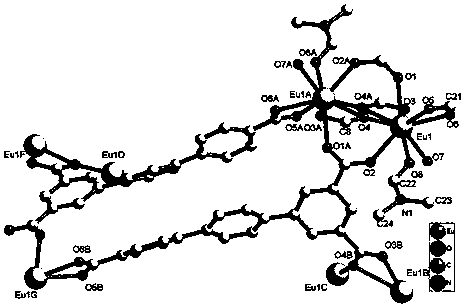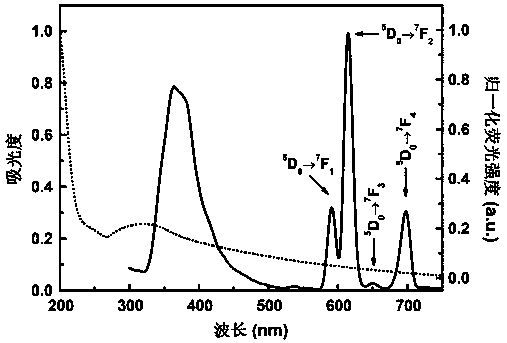Method for detecting phosphate ions based on dual-emission europium metal organic framework material
A metal-organic framework and phosphate ion technology, which is applied in the direction of luminescent materials, analytical materials, material excitation analysis, etc., can solve the problems of ineffective implementation of analysis and detection, expensive, lengthy sample pretreatment, etc., and achieve good application value and detection The effect of low limit and visible detection process
- Summary
- Abstract
- Description
- Claims
- Application Information
AI Technical Summary
Problems solved by technology
Method used
Image
Examples
Embodiment 1
[0040] Synthesis and Characterization of Dual-emission Lanthanide Europium Metal-Organic Frameworks
[0041] 20.04 mg, 0.05 mmol / L of Eu(Ac) 3 4H 2 O and 8.7 mg, 0.05 mmol / L of terphenyl-3,4ʹʹ,5-tricarboxylic acid mixture were stirred in 2 mL of deionized water and 4 mL of DMF for 0.5 hours, and then 5 μL of 2mol / L HNO 3 . Subsequently, the resulting solution was transferred to a stainless steel autoclave with a polytetrafluoroethylene liner, heated at 120°C for 48 hours, and cooled to 25°C after 20 hours of cooling to obtain colorless blocky crystals. Washed several times with deionized water and ether. Based on ligand H 3 The yield of L: 39%. The theoretical value (%) of element analysis of C45H35Eu2NO16 is: C 47.01, H 3.07, N 1.22; the measured value (%) is: C 47.31, H 3.29, N 1.38; indicating that the elemental composition is basically consistent with the theoretical value.
[0042] Characterize the structure and properties of the metal-organic framework prepared ab...
Embodiment 2
[0050] A method for detecting phosphate ions based on dual-emission europium metal-organic framework materials:
[0051] (1) The prepared dual-emission europium metal-organic framework material was uniformly dispersed in an aqueous solution to prepare a suspension solution with a concentration of 85 mg / L as the detection system, and 250 nm was used as the excitation wavelength, and the test system was at 368 nm and 614 nm the fluorescence emission peak;
[0052] (2) Add the solution to be tested into the detection system and mix evenly, let it stand to ensure the interaction between the analyte and the material, and investigate the changes in the fluorescence emission intensity at 368 nm and 614 nm respectively; the anion refers to : Phosphate ion;
[0053] The general chemical formula of the double emission europium metal organic framework material used is: [Eu 2 (L) 2 (H 2 O) 2 (DMF) 2 ], L is terphenyl-3,4ʹʹ,5-tricarboxylic acid, as a ligand, Eu 3+ As a metal center,...
Embodiment 3
[0056] Determination of UV absorption spectrum and fluorescence emission spectrum of metal organic framework materials used
[0057] The metal-organic framework material prepared in Example 1 above was dispersed into an aqueous solution, and the ultraviolet-visible absorption spectrum and fluorescence emission spectrum of the material were tested, as shown in the attached image 3 As shown, there is a broad absorption peak at 320 nm in the UV-visible absorption spectrum of metal organic framework materials, which is attributed to jump. Under the excitation of excitation light, the metal-organic framework material exhibits ligand-based and Eu-based 3+ The sharp features of the emission. In the spectral emission band in the range 592-698 nm, the emission maximum is located at 614 nm, assigned to 5 D. 0 → 7 f 2 The electronic transition of , the side peaks are located at 592 nm ( 5 D. 0 → 7 f 1 ), 650 nm ( 5 D. 0 → 7 f 3 ) and 698 nm ( 5 D. 0 → 7 f 4 ) place. ...
PUM
 Login to View More
Login to View More Abstract
Description
Claims
Application Information
 Login to View More
Login to View More - R&D
- Intellectual Property
- Life Sciences
- Materials
- Tech Scout
- Unparalleled Data Quality
- Higher Quality Content
- 60% Fewer Hallucinations
Browse by: Latest US Patents, China's latest patents, Technical Efficacy Thesaurus, Application Domain, Technology Topic, Popular Technical Reports.
© 2025 PatSnap. All rights reserved.Legal|Privacy policy|Modern Slavery Act Transparency Statement|Sitemap|About US| Contact US: help@patsnap.com



